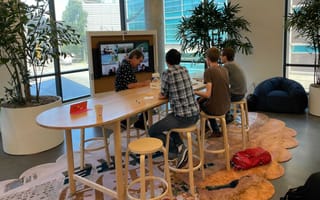Over the past few months, Royce Ausburn, staff software engineer at Dropbox, felt the same way many tech workers have since the start of the pandemic: burned out.
He couldn’t relate to the stereotype of the sole developer coding away in a dimly lit room, and wanted to lean into the culture of collaboration his employer celebrated. He missed the simple in-person moments: bouncing ideas off his peers, water cooler talk and grabbing a drink after work. He knew from experience that those moments could lead to innovation.
Just when Ausburn most needed a reminder of what was possible through remote collaboration, one appeared in the form of Dropbox’s virtual Hack Week. During the event, which challenged employees and interns to find solutions to obstacles at work, Ausburn was able to table ongoing projects and focus on solving pain points. Shortly thereafter, he decided to take the challenge one step further.
“I realized that we needed to start intentionally building a new, virtual-first staff engineering community,” Ausburn said.
Ausburn called his colleagues together for a brainstorming session that resulted in a virtual summit for staff engineers. Armed with company resources like the Virtual First Toolkit, Dropbox’s official guide to remote work, the engineers were able to expand upon what they wanted the term “virtual-first” to mean for their department and the company as a whole.
The summit, which is set to take place later this year, will foster a sense of community that so many have missed during lockdown — and it will do so using software tools that the team probably would never have discovered working from the office.
Virtual First
Tell us a bit about the virtual summit for staff engineers. How did this get started? How has it grown since?
I’m helping organize a virtual summit for the staff engineers at Dropbox. The main theme of the summit is, “Building our virtual-first staff engineering community.” The plan is for us to come together as a group to discuss the company’s challenges and how to solve them, get to know one another better, and form a community.
I tend to take on a lot, and in my career I’ve learned that I need to turn to my peers, my workmates and my manager to give me some perspective or to share the load. This was fairly easy and automatic in the office. I’d just have coffee or lunch with someone. It seemed to me that in a virtual-first world, community-building required a little more intention.
The summit didn’t occur to me as the first step. During our recent Hack Week, a few of us staff engineers decided we’d do an “ask a staff engineer anything” on Slack, allowing anyone at the company to ask a question. We had a great response from the engineers. I think we were all missing something in our old in-person connections. After some discussions, a small group of us emailed our CEO, president, a few VPs and senior directors to see if they’d participate in a summit — they all enthusiastically agreed.
We’re about to email a survey out to many of our engineers to get a pulse on what we believe the community should focus its attention on during the summit. I appreciate that many of us are comfortable sharing how we really feel, which helps break the ice and gets all of us to engage with some of the most pressing issues. We’re all looking forward to seeing the results.
What they do
What is one of your favorite virtual-first brainstorming tools?
When we were in the office, my team would usually use Post-it Notes for brainstorming purposes. The typical process was to individually write out some ideas, manually group them on a whiteboard, and discuss a few. When we started working from home, we began using Dropbox Paper. It turns out to be a much better way. We’ll spend a few minutes in video chat discussing what we’re brainstorming and setting the stage, and then we’ll all mute and spend a few minutes writing bullet points into the same Paper document. We’ll then spend a few minutes voting by putting an emoji next to the items we think are worth discussing more. After that, as a team, we will discuss the ones that got the most votes.
In the past, we’d only get through a few points, and not necessarily the most interesting points. This way, the best items surface to the team quickly. It’s also more inclusive. Not all of us like speaking up in meetings or sharing brainstormed ideas because they’re so raw. Many folks feel more comfortable with this approach because we get to see each other’s wacky, early ideas. I usually peek at others’ while we are silently brainstorming, which can also inspire more thoughts.
What’s a hurdle or challenge associated with working virtual-first? How does your team address it?
One of the things that makes Dropbox special are the people. We’re very good at hiring people who are great to work with! So, maintaining human connection with the folks we work with is a challenge now that we don’t have an office to automatically bring us together.
This means we have to put in a bit more effort to build and maintain those connections. Fortunately, investing time and effort into maintaining connection is a top priority across the company. Even small things like making time for non-work chat at the beginning of meetings, virtual happy hours, outdoor team lunches and team social chats can go a long way.
What’s an example of an exciting project your team currently or previously worked on that evolved from a virtual brainstorming session? How did it come to be?
Brainstorming is pretty central to how I approach work generally, so anything I’m involved in is pretty likely to include a brainstorming session or two. Right now my team’s main focus is making our identity platform able to support the development and acquisition of new products not based upon the Dropbox production stack. It turns out it’s fairly difficult to do this, seeing as a lot of the company’s existing product and commercial platforms were written or deployed assuming there’d just be one product.
Understanding what this means for Dropbox’s platforms and architecture has required a lot of ideation and collaboration with parts of the company we don’t normally interact with. I find it fascinating. It feels like a once-in-a-career opportunity to shape a business in this way. We’re just getting started.





